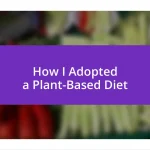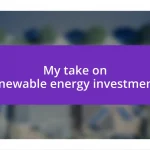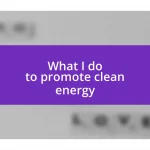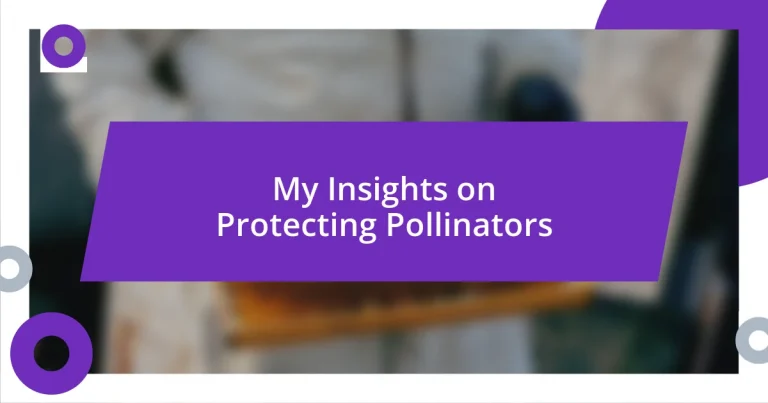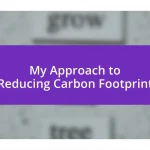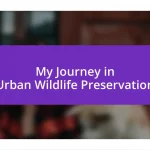Key takeaways:
- Pollinators are vital for the reproduction of over 75% of flowering plants and support biodiversity within ecosystems.
- Threats such as habitat loss, pesticide use, and climate change severely impact pollinator populations, highlighting the urgent need for conservation efforts.
- Community involvement, policy advocacy, and best gardening practices can significantly contribute to the protection and preservation of pollinators and their habitats.
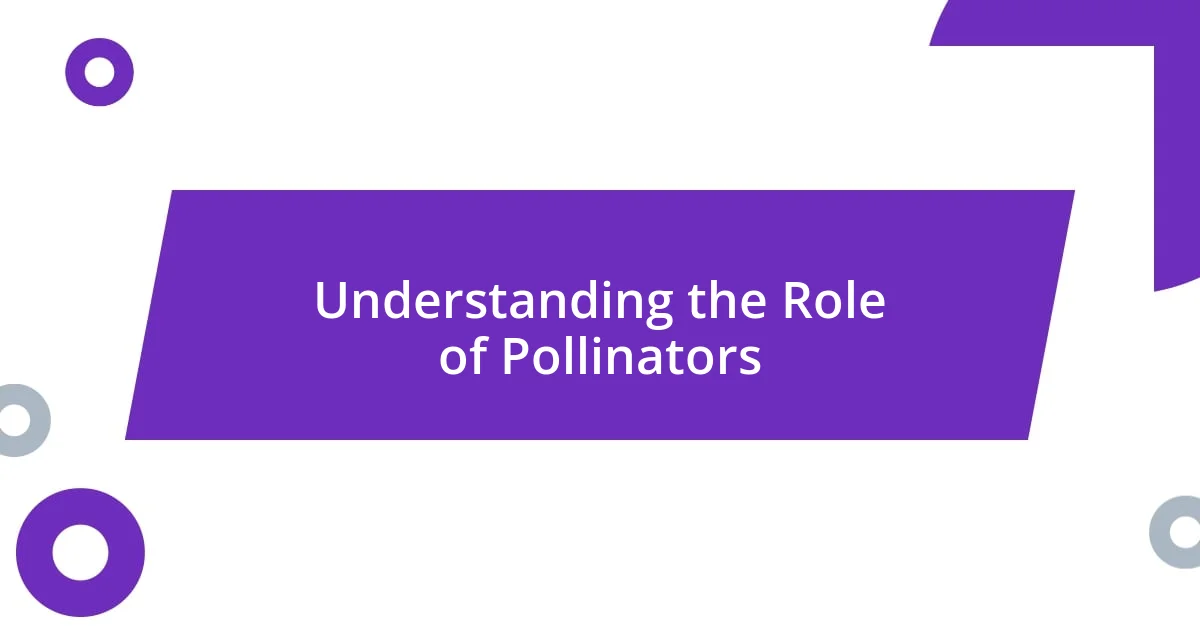
Understanding the Role of Pollinators
Pollinators, like bees and butterflies, are essential to our ecosystem, contributing to the reproduction of over 75% of the world’s flowering plants. When I first learned about their crucial role, it struck me how intertwined our food systems are with these tiny creatures. Have you ever stopped to think about how many foods we enjoy—fruits, vegetables, even coffee—depend on their hard work?
I still remember the first time I saw a honeybee working tirelessly on my lavender plants. Watching its meticulous dance from flower to flower gave me a deeper appreciation for the intricate relationships in nature. It made me realize that without pollinators, our landscapes would look vastly different—much less vibrant and diverse.
Furthermore, pollinators help sustain entire ecosystems by promoting biodiversity. Their activity not only supports our crops but also fosters habitats for countless species. This connection prompts me to wonder: how can we not just witness this beauty, but also take responsibility for its preservation? It is a call to action, reminding me that we share this planet, and it’s our duty to protect those who make our world flourish.
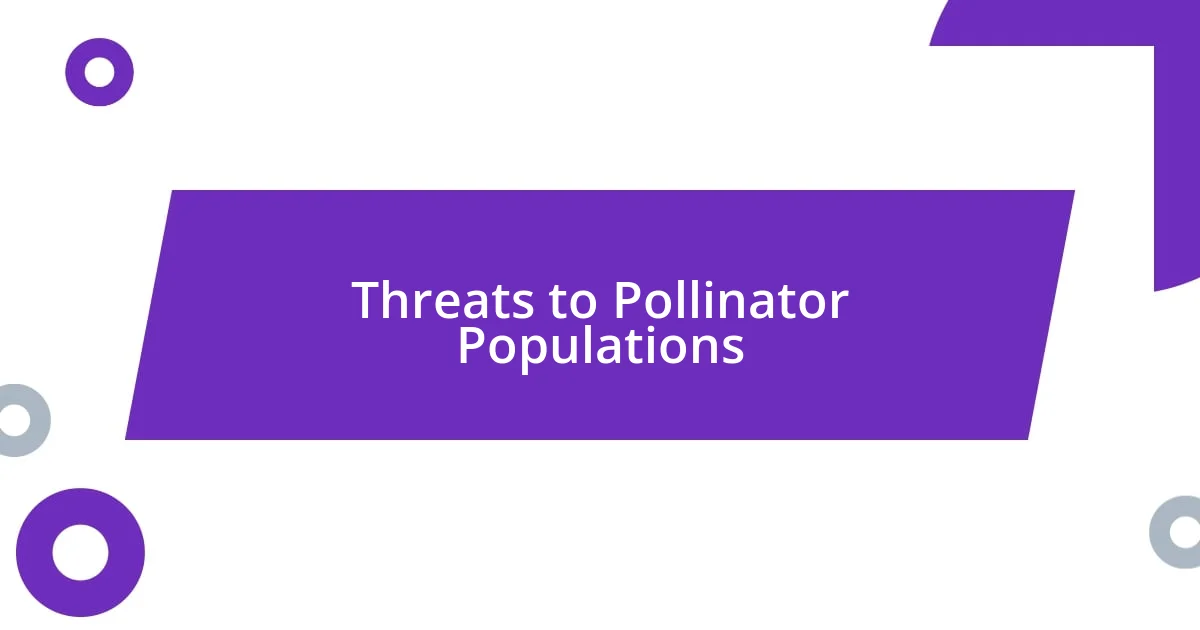
Threats to Pollinator Populations
Pollinators face numerous threats that jeopardize their populations. One major threat is habitat loss, often due to urbanization and agricultural expansion. I once took a walk through a once-flourishing meadow, now replaced by concrete and buildings. It was heartbreaking to see the vibrant wildlife diminished; it made me realize how quickly an ecosystem can change and how that impacts the pollinators reliant on these areas.
Another significant threat is pesticide use. Chemicals designed to eliminate pests can inadvertently harm pollinators. During a backyard gardening project, I opted for organic methods, knowing firsthand the devastating effects of chemical sprays on bees. It made me reflect on how our choices, even in our gardens, have a ripple effect that extends to the larger ecosystem. Every bee I saw felt like a small victory against a tide of harmful practices.
Climate change compounds these issues, altering seasonal patterns and disrupting the delicate balance of nature. I often think about the time I noticed that my favorite flowers bloomed weeks earlier than they used to. It made me question how this shift affects the lifecycle of pollinators, who rely on a synchronized rhythm with flowering plants. These changes serve as a stark reminder that protecting pollinators is not just an environmental concern but a pressing necessity for our future.
| Threat | Description |
|---|---|
| Habitat Loss | Urbanization and agricultural expansion reduce natural spaces for pollinators. |
| Pesticide Use | Chemicals used for pest control can harm pollinators. |
| Climate Change | Shifts in temperature and weather disrupt the lifecycle of pollinators. |
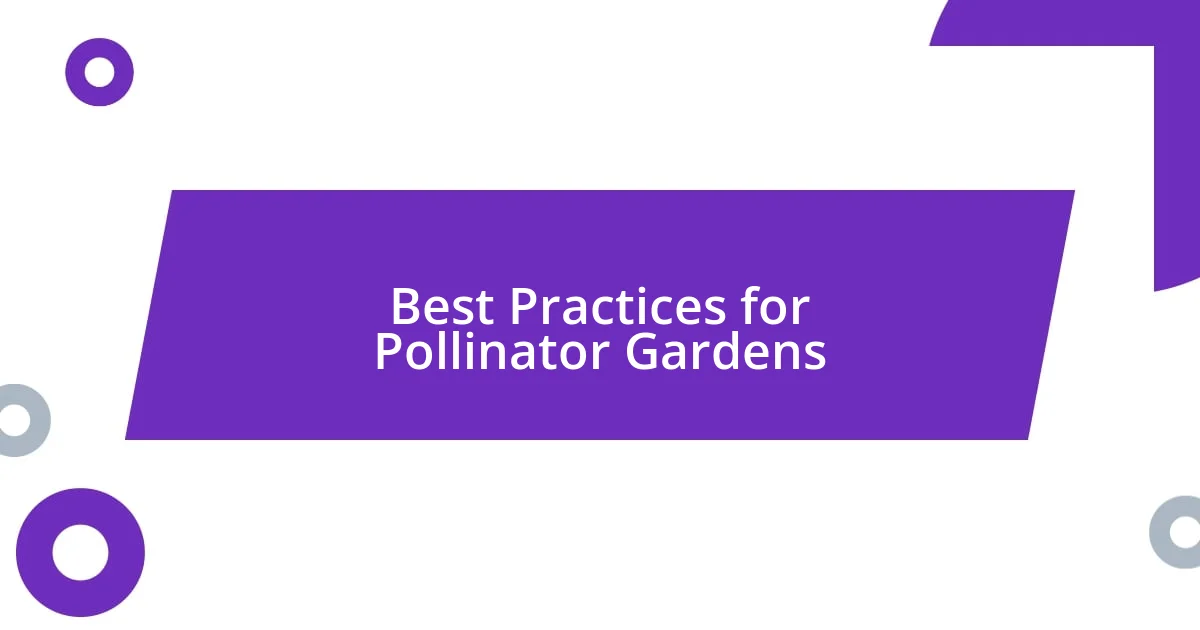
Best Practices for Pollinator Gardens
Creating a pollinator garden is a fulfilling way to support these vital creatures. I vividly recall the first time I planted a butterfly bush; it was like turning on a light in my backyard. Suddenly, it became a bustling hub of activity. To make your garden a haven for pollinators, consider the following best practices:
- Diverse Plant Selection: Choose plants with various blooming times to provide food throughout the season.
- Native Plants: Incorporate native species that are well-adapted to your region and are more appealing to local pollinators.
- Plant in Clusters: Grouping plants together attracts more pollinators by making it easier for them to move from flower to flower.
- Avoid Chemicals: By using organic gardening methods, you create a safer environment for pollinators.
- Provide Shelter: Create nesting sites or leave some areas wild to offer homes for bees and other insects.
Each time I step into my garden, I notice someone new—bees flitting about and butterflies gliding gracefully, engaging with the blooms. This experience always reminds me that a pollinator garden isn’t just about flowers; it’s a symbiotic relationship where we can all thrive together. The joy and vibrancy they bring spin a deeper appreciation of nature’s balance, something I wish to encourage in every backyard.
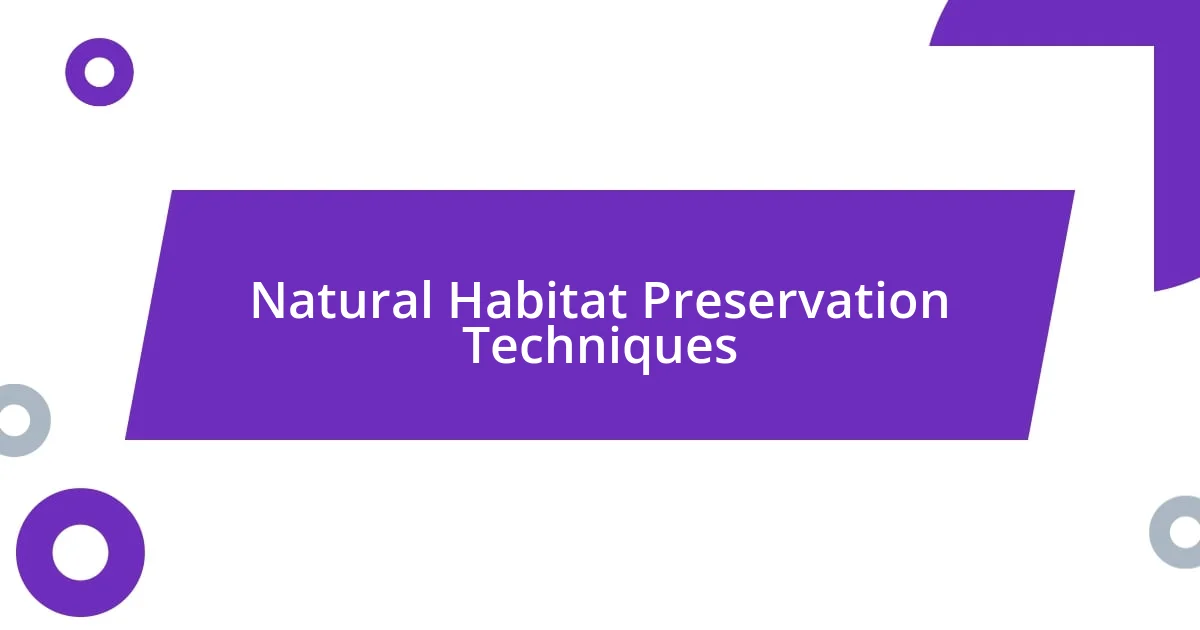
Natural Habitat Preservation Techniques
One of the simplest yet effective techniques for preserving natural habitats is the concept of creating buffer zones. I remember visiting a local nature reserve where they had implemented grassy margins around fields. These zones not only provided safe havens for pollinators but also served as a natural filter, reducing pesticide runoff into adjacent habitats. It made me wonder—what if every farm embraced this technique? The positive impact could be tremendous.
Active rewilding is another fascinating approach. I once participated in a community project where we transformed a neglected plot into a thriving wildflower meadow. The change was astonishing! In just a few weeks, we saw an influx of butterflies and bees that had disappeared from the area for years. It underscored for me how quickly nature can bounce back when we give it the right conditions. This experience filled me with hope and reinforced my belief in the power of grassroots efforts.
Moreover, promoting sustainable land-use practices is essential for preserving pollinator habitats. During a workshop, I learned how agroecology techniques—not only benefit farmers but also enhance biodiversity. By practicing crop rotation and intercropping, farmers can create a mosaic of habitats within their fields. It really got me thinking about how modifying our agricultural practices could usher in a new era of coexistence between humans and pollinators. Don’t you think it’s time we reimagined how we interact with the land?
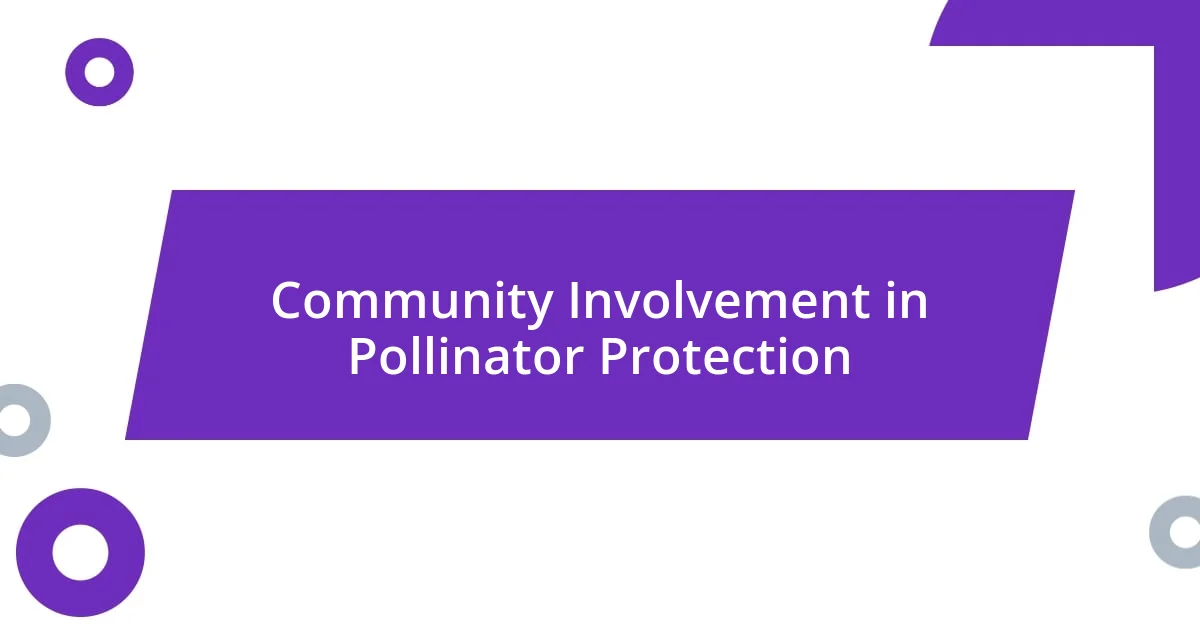
Community Involvement in Pollinator Protection
Community involvement can truly make a difference in protecting pollinators. I remember when my neighborhood organized a clean-up day to remove trash from nearby parks and gardens. It was inspiring to see families, kids, and even local businesses come together, each doing their part to create a healthier environment. Through these collective efforts, we not only beautified our community but also increased awareness about the importance of protecting our buzzing friends.
Participating in local workshops can also be a game-changer. I attended one that focused on DIY bee hotels, which are essential for solitary bees that don’t live in hives. It was fascinating to see adults and children alike engaged in building these little havens. I realized then that hands-on activities foster a sense of responsibility and connection to nature. Have you ever built something that made you feel closer to the environment? It changes your perspective.
Lastly, we can leverage social media to spread the word about pollinator issues. I shared a simple post about my experiences with a native plant garden, and it sparked conversations with others in my area. The best part? People started sharing their own stories and tips! It really highlighted how a network of passionate individuals can strengthen our commitment to pollinator protection. Isn’t it amazing how technology can bring us together for a common cause?
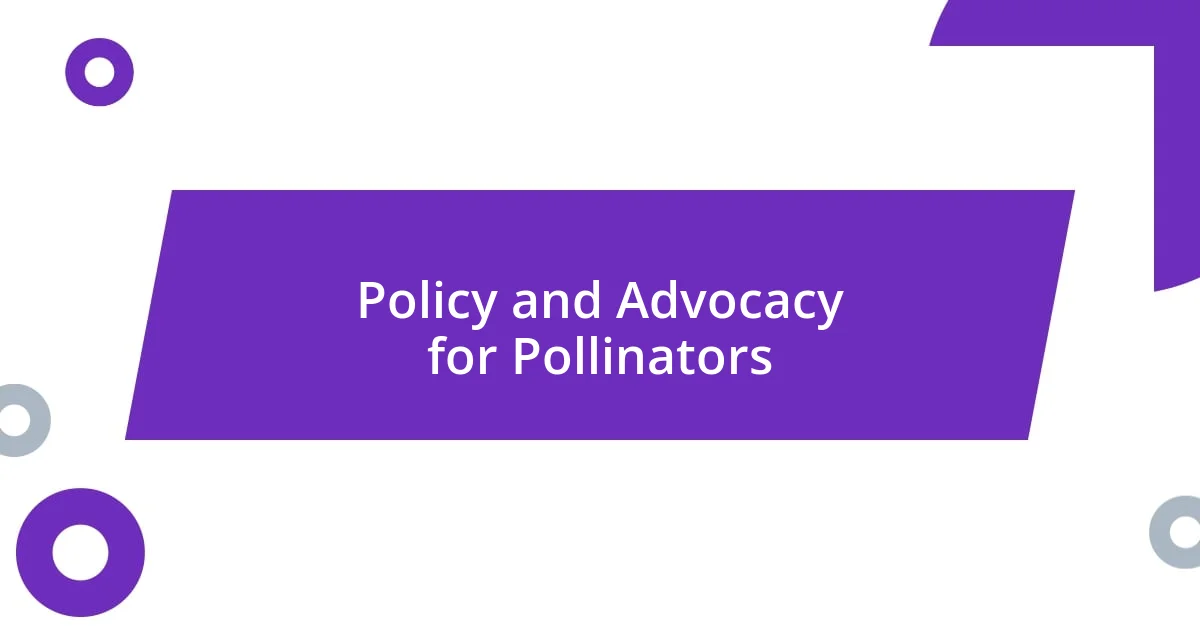
Policy and Advocacy for Pollinators
It’s fascinating how policy changes can directly impact the survival of pollinators. Recently, I read about a local initiative that encouraged lawmakers to support stricter regulations on pesticide use. Seeing the community band together to advocate for a healthier environment made me realize how powerful collective voices can be. Have you ever participated in a petition or rally? The energy at those events can be incredibly motivating!
Advocacy can take many forms, from grassroots campaigns to involvement with national organizations. I once volunteered with a group pushing for bee-friendly legislation that aimed to protect habitats from urban development. The camaraderie among the participants was palpable; it felt like we were on a mission. Each phone call made, each letter written, resonated deeply within me as I understood how interconnected our efforts are when striving for something bigger than ourselves.
Moreover, it’s essential to engage with local policymakers. I remember attending a town hall meeting where experts discussed the importance of pollinator corridors. Connecting scientific data to community interests truly struck a chord with me. It was eye-opening to see how readily available information could influence decision-making. What if we all took the time to share what we know? Our insights could spark crucial conversations that lead to positive change for pollinators everywhere.

